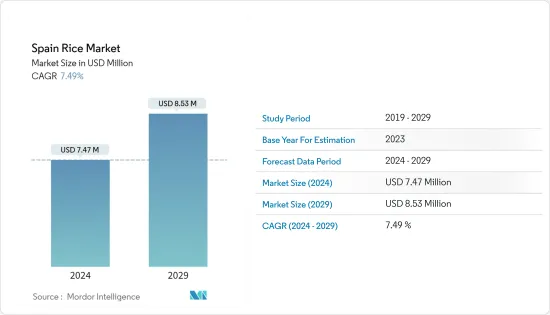PUBLISHER: Mordor Intelligence | PRODUCT CODE: 1444706

PUBLISHER: Mordor Intelligence | PRODUCT CODE: 1444706
Spain Rice - Market Share Analysis, Industry Trends & Statistics, Growth Forecasts (2024 - 2029)
The Spain Rice Market size is estimated at USD 7.47 million in 2024, and is expected to reach USD 8.53 million by 2029, growing at a CAGR of 7.49% during the forecast period (2024-2029).

Key Highlights
- Spain is the second-largest producer of rice in Europe, with 25-30% of total European production. The major rice-producing areas in the country are Andalucia, Extremadura, Cataluna, Comunidad Valencia, Aragon, and Navarra. There are three key varieties, Bahia, Senia, and Bomba, with Bomba being the best. Spain's rice market is concentrated around imports due to a continuous decrease in domestic production.
- Rice is cultivated in six of the country's total 17 administrative regions. The crop is grown from April to October, with harvest peaking in September. Rice in Spain is mostly cultivated under flood irrigation conditions from May to October. Rice cultivation in traditional areas (Delta del Ebro, Marismas del Guadalquivir, and Valencia) follows a monoculture system. Although rice is one of the most salt-sensitive crops, cultivation using freshwater flood irrigation allows the lowering of salinity levels. Thus, its cultivation is highly carried out in non-salinized field areas.
- The preferred type in Spain is short-grain rice, which has a long tradition in the Mediterranean coastal regions. Long-grain varieties are mainly cultivated in rice areas located in southern Spain (Extremadura and Marismas del Guadalquivir). In contrast, short-medium-grain rice is cultivated in the other four areas in northeastern Spain.
- Argentina, Pakistan, Thailand, Myanmar, and Italy are some major rice exporters to Spain. Rice imports in Spain mainly consist of Rice Indica. For Japonica, the country is self-sufficient. Spain contributes 15% of exports of Japonica rice in the EU, while Italy contributes 70%. Due to a decrease in rice production and increasing imports to Spain, the high demand for rice in the country is expected to drive the market in the coming year.
Spain Rice Market Trends
Increasing Rice Consumption in the Country
Increased consumption of rice has been observed over the years in the country. Rice per capita consumption has remained stable from the past five years till 2021, observing a slight increase in 2020. Rice is a solid staple in Spain, popular as pasta, potato, and bread. Because of its nutritional value and less cooking time, it is more popular in Spain. People of Spain prefer different types of rice in their daily food, which is expected to drive the market.
The most acceptable rice in Spain is of small and round shape as it consumes less time to cook. However, production and area harvested for rice have decreased over the years. Spain's rice consumption is completely dependent on imports. Domestic production is insufficient for the country as consumption is huge. However, Spain is the major exporter of rice in many European countries.
Spain has been ranked 90th within the group of 154 countries in terms of interest rate on rice consumption per capita. Valencia and the Balearic Islands consume the most rice, while demand is lowest in Castile La Mancha, Galicia, and Navarre. 75% of rice is purchased in supermarkets, while the remaining 25% is sold in hypermarkets (18%), specialized stores (2%), and other types of shops (4%). The total rice import quantity was noted to be 287,957 metric tons in 2021, which is more than the previous year. The increasing consumption of rice varieties in the country is likely to drive the market during the forecast period.
Argentina - A Major Supplier of Rice to Spain
Even though Spain is the second-largest producer of rice in Europe, domestic production alone cannot meet the demand. In 2022, production in some subregions of Spain was observed to be low because of drought due to high temperatures and low rainfall in some areas. According to the Ministry of the Ecological Transition's report, as of the beginning of August 2022, the volume of water in the Spanish hydrophobic reserve was 39%, almost 10% less than in 2021. Therefore the country depends on imports to meet its demand. Argentina, Maynmar, Guana, Pakistan, and Italy are the leading rice suppliers to Spain. Spain is not only an active importer of rice but also an exporter within Europe.
In 2020, Spain became the world's 55th largest importer of rice by importing rice valued at USD 133 million. Rice was the 39th imported product in Spain. Argentina's export of rice to Spain in 2021 was recorded at USD 25,188, which increased in 2021 compared to 2020. According to the ITC Trademap, in 2021, the total volume of rice imported from the world was 287,957 ton. Argentina was at the top of the list of rice exporters to Spain. Rice imports in Spain mainly consist of Rice Indica. However, for the Japonica variety, the country is self-sufficient. Spain contributes 15% of exports of Japonica rice to the EU, and Italy accounts for 70%. The structure of rice imports has changed over the last years, with an increase in imports of milled rice and a decrease in imports of husked rice (non-Basmati).
Spain Rice Industry Overview
Additional Benefits:
- The market estimate (ME) sheet in Excel format
- 3 months of analyst support
TABLE OF CONTENTS
1 INTRODUCTION
- 1.1 Study Assumptions and Market Definition
- 1.2 Scope of the Study
2 RESEARCH METHODOLOGY
3 EXECUTIVE SUMMARY
4 MARKET DYNAMICS
- 4.1 Market Overview
- 4.2 Market Drivers
- 4.3 Market Restraints
- 4.4 Value Chain Analysis
5 MARKET SEGMENTATION
- 5.1 Production Analysis
- 5.1.1 Consumption Analysis and Market Value
- 5.1.2 Import Market Analysis (Volume and Value)
- 5.1.3 Export Market Analysis (Volume and Value)
- 5.1.4 Price Trend Analysis
6 MARKET OPPORTUNITIES AND FUTURE TRENDS




